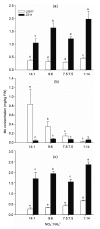Uptake, transport and distribution of molybdenum in two oilseed rape (Brassica napus L.) cultivars under different nitrate/ammonium ratios
- PMID: 28585427
- PMCID: PMC5482046
- DOI: 10.1631/jzus.B1600249
Uptake, transport and distribution of molybdenum in two oilseed rape (Brassica napus L.) cultivars under different nitrate/ammonium ratios
Abstract
Objectives: To investigate the effects of different nitrate sources on the uptake, transport, and distribution of molybdenum (Mo) between two oilseed rape (Brassica napus L.) cultivars, L0917 and ZS11.
Methods: A hydroponic culture experiment was conducted with four nitrate/ammonium (NO3-:NH4+) ratios (14:1, 9:6, 7.5:7.5, and 1:14) at a constant nitrogen concentration of 15 mmol/L. We examined Mo concentrations in roots, shoots, xylem and phloem sap, and subcellular fractions of leaves to contrast Mo uptake, transport, and subcellular distribution between ZS11 and L0917.
Results: Both the cultivars showed maximum biomass and Mo accumulation at the 7.5:7.5 ratio of NO3-:NH4+ while those were decreased by the 14:1 and 1:14 treatments. However, the percentages of root Mo (14.8% and 15.0% for L0917 and ZS11, respectively) were low under the 7.5:7.5 treatment, suggesting that the equal NO3-:NH4+ ratio promoted Mo transportation from root to shoot. The xylem sap Mo concentration and phloem sap Mo accumulation of L0917 were lower than those of ZS11 under the 1:14 treatment, which suggests that higher NO3-:NH4+ ratio was more beneficial for L0917. On the contrary, a lower NO3-:NH4+ ratio was more beneficial for ZS11 to transport and remobilize Mo. Furthermore, the Mo concentrations of both the cultivars' leaf organelles were increased but the Mo accumulations of the cell wall and soluble fraction were reduced significantly under the 14:1 treatment, meaning that more Mo was accumulated in organelles under the highest NO3-:NH4+ ratio.
Conclusions: This investigation demonstrated that the capacities of Mo absorption, transportation and subcellular distribution play an important role in genotype-dependent differences in Mo accumulation under low or high NO3-:NH4+ ratio conditions.
Keywords: Brassica napus L.; Nitrogen source; Transport; Subcellular distribution; Xylem; Phloem.
Conflict of interest statement
This article does not contain any studies with human or animal subjects performed by any of the authors.
Figures







Similar articles
-
Effects of tungsten on uptake, transport and subcellular distribution of molybdenum in oilseed rape at two different molybdenum levels.Plant Sci. 2017 Mar;256:87-93. doi: 10.1016/j.plantsci.2016.12.009. Epub 2016 Dec 23. Plant Sci. 2017. PMID: 28167042
-
Xylem transport and gene expression play decisive roles in cadmium accumulation in shoots of two oilseed rape cultivars (Brassica napus).Chemosphere. 2015 Jan;119:1217-1223. doi: 10.1016/j.chemosphere.2014.09.099. Epub 2014 Nov 1. Chemosphere. 2015. PMID: 25460764
-
Boron uptake and distribution by oilseed rape (Brassica napus L.) as affected by different nitrogen forms under low and high boron supply.Plant Physiol Biochem. 2021 Apr;161:156-165. doi: 10.1016/j.plaphy.2021.02.009. Epub 2021 Feb 13. Plant Physiol Biochem. 2021. PMID: 33609922
-
A role for shoot protein in shoot-root dry matter allocation in higher plants.Ann Bot. 2006 Jan;97(1):3-10. doi: 10.1093/aob/mcj009. Epub 2005 Nov 18. Ann Bot. 2006. PMID: 16299006 Free PMC article. Review.
-
Photon costs of shoot and root NO3-, and root NH4+, assimilation in terrestrial vascular plants considering associated pH regulation, osmotic and ontogenetic effects.Photosynth Res. 2023 Feb;155(2):127-137. doi: 10.1007/s11120-022-00975-y. Epub 2022 Nov 23. Photosynth Res. 2023. PMID: 36418758 Review.
References
-
- Babalar M, Sokri SM, Lesani H, et al. Effects of nitrate:ammonium ratios on vegetative growth and mineral element composition in leaves of apple. J Plant Nutr. 2015;38(14):2247–2258. doi: 10.1080/01904167.2014.964365. - DOI
-
- Barłóg P, Grzebisz W. Effect of timing and nitrogen fertilizer application on winter oilseed rape (Brassica napus L.). I. Growth dynamics and seed yield. J Agron Crop Sci. 2004;190(5):305–313. doi: 10.1111/j.1439-037X.2004.00108.x. - DOI
-
- Barłóg P, Grzebisz W. Effect of timing and nitrogen fertilizer application on winter oilseed rape (Brassica napus L.). II. Nitrogen uptake dynamics and fertilizer efficiency. J Agron Crop Sci. 2004;190(5):314–323. doi: 10.1111/j.1439-037X.2004.00109.x. - DOI
-
- Behrens T, Horst WJ, Wiesler F. Effect of rate, timing and form of nitrogen application on yield formation and nitrogen balance in oilseed rape production. In: Horst WJ, Schenk MK, Bürkert A, et al., editors. Plant Nutrition. Springer Netherlands; 2002. pp. 800–801. - DOI
-
- Britto DT, Kronzucker HJ. NH4 + toxicity in higher plants: a critical review. J Plant Physiol. 2002;159(6):567–584. doi: 10.1078/0176-1617-0774. - DOI
MeSH terms
Substances
LinkOut - more resources
Full Text Sources
Other Literature Sources
Miscellaneous

